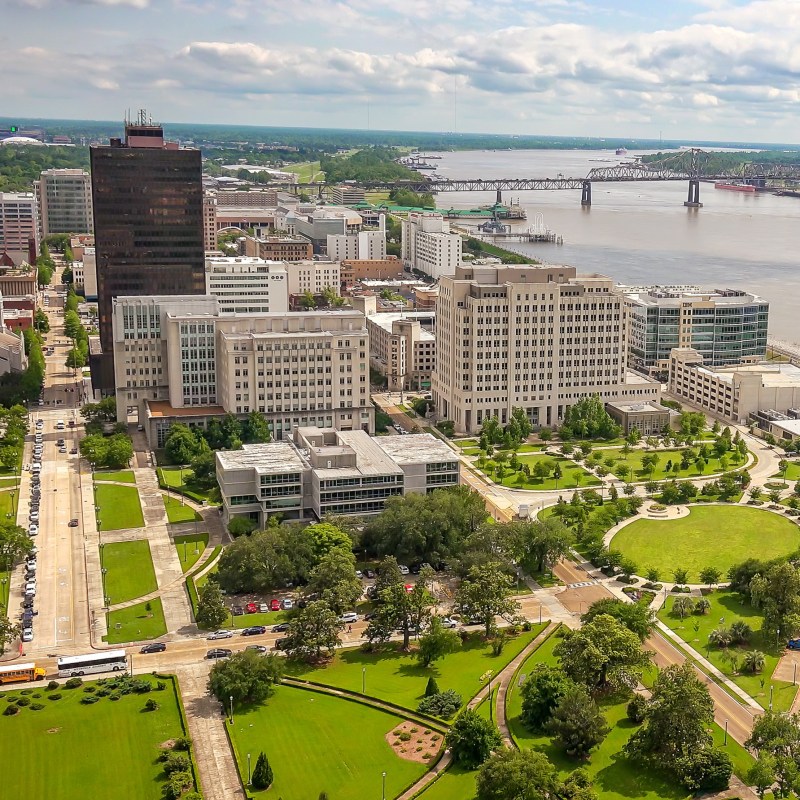
There’s no doubt about it: New Orleans is one of our favorite places in the country — perhaps even on the planet. Its food, music, and general joie de vivre truly set this special place apart.
Videos by TravelAwaits
But once you’ve had your fill of fun in the Crescent City, don’t write off the rest of the state. Consider a road trip to discover more of Louisiana’s Cajun country and culture. Here are some of our favorite stops on a road trip from New Orleans to Lake Charles.

New Orleans
Whether it’s your first visit or you’re a Laissez les bons temps rouler pro, New Orleans never fails to dazzle and charm.
The city’s historic heart is the French Quarter, and while you should certainly spend time perusing the antique shops along Royal, enjoying a cocktail or two at Muriel’s, grabbing an order of sugary beignets from Cafe Du Monde, strolling Jackson Square, and wandering the French Quarter Market, there’s much more to the city than that small slice.
Head uptown on the streetcar to marvel at the grand mansions, get away from the tourists, and eat like a local at Jacques-Imo’s. Take a spooky cemetery tour or revisit American military history at the National WWII Museum. Get your live jazz fix at the legendary Tipitina’s, and when you’re wrapped for the evening, The Roosevelt offers a luxe place to rest after all the excitement.
Whether you spend a night or a week, you won’t scratch the surface of what this magical place has to offer. Read much more about New Orleans here.

River Road
From New Orleans, we suggest bypassing the interstate. Instead, take the historic River Road north toward Baton Rouge. This 70-mile stretch, which runs right along the Mississippi, is a National Register of Historic Places Travel Itinerary and will take you along levees, past grand live oaks dripping with Spanish moss, and from one magnificent plantation to another.
Oak Alley Plantation, the estate that was renovated in the 1920s, paved the way for the revival of this historic route. Tours are available there and at many of the antebellum homes.
This history of this area is complicated and tragic. The River Road African American Museum in Donaldsonville goes beyond the romanticism of the sweeping plantation homes to explore the 300-year history of African Americans in the South and explain how they built up the region under unimaginable duress.

Baton Rouge
Louisiana’s state capital, Baton Rouge (“Red Stick”), was named 300 years ago by French explorers who noted a stripped red cypress tree marking the border between the hunting grounds of two different Native American tribes. The city is a vibrant place that boasts two state capitol buildings, the state’s flagship university, beautiful parks, and some terrific places to grab a bite or a brew.
Head to the downtown riverfront district and consider the differences between the Old State Capitol, with its castlelike appearance, and the New State Capitol, the art-deco spike used by state lawmakers today. For an incredible view of the river and city, head to the rooftop observation deck! Out front, you’ll find a statue of Huey Long, the Louisiana governor and U.S. senator who was assassinated in the New State Capitol’s lobby in 1935.
For more history, go straight to the riverfront and step aboard the USS Kidd Veterans Museum, a World War II-era destroyer preserved in her original wartime configuration, to learn more about what members of the military faced during battles on the high seas.
From downtown, head south and stroll Louisiana State University’s iconic campus set in ancient live oaks, and grab a bite and cocktail or two on the edge of campus at The Chimes, an iconic eatery that’s been serving up great food and drinks for more than 25 years.
Stay the night downtown at the Watermark, a luxe hotel built into the historic Louisiana Trust & Savings Bank.

Avery Island
From Baton Rouge, head west on Interstate 10 across the Atchafalaya National Wildlife Refuge, and then jog to the south a bit past New Iberia for a true taste of Louisiana heat. Here, you’ll find Avery Island, home to one of the state’s most famous exports: Tabasco!
Avery Island is built on a salt dome and sits just north of Vermilion Bay. This is the spot where Edmund McIlhenny first created his fiery red pepper sauce in 1868. McIlhenny was an avid gardener, and for his hot sauce, he used hot peppers from Mexico.
Today, you can tour the Tabasco factory and see for yourself where the peppers are barrel-aged and bottled. The company also offers cooking classes and a culinary tour. Don’t forget to take time to peruse the gift shop and stroll the adjacent gardens, where you can admire the gorgeous bayou landscape.

Lafayette
Head back north to Interstate 10 and take it west for a few more miles, and you’ll soon reach the heart of Cajun country: Lafayette.
To learn more about the exiled French Canadians who settled here and became Louisiana’s beloved Cajuns, head to the excellent Acadian Cultural Center. Admission is free, and the center, which is operated by the National Park Service as part of the Jean Lafitte National Historical Park and Preserve, is open every day but Monday.
If you’re a fan of pop art, the George Rodrigue Gallery is a must-stop; fans can view the late Cajun artist’s works, including those featuring his famed Blue Dog.
Outdoor enthusiasts should make time for Lake Martin. This is one of the most photographed swamps in the South, and you’ll see egrets, herons, ibis, and even spoonbills, along with other critters including turtles, lizards, and alligators.
Refuel at Louisiana Crawfish Time, a down-home favorite that sells shellfish boiled, fried, and on the half shell, plus all the fixings. The Juliet Hotel is an excellent and affordable spot to spend the night.
The Best Stop Supermarket
For a decadent, pork-laden snack, make plans for a quick pit stop in Scott (just northwest of Lafayette) at The Best Stop Supermarket. This down-home grocery store is Cajun through and through and offers some of the best crackling (pork rind) boudin (Cajun-style spicy sausage) and boudin balls (deep-fried rice-and-sausage balls) anywhere in Louisiana.

Crowley
Continue heading west on the interstate until you reach the place that’s known as the Rice Capital of America. Crowley is home to numerous shallow ponds and low prairies where rice and crawfish are produced.
The downtown area is worth a drive for its oak-lined streets and Victorian homes. There are a total of 200 buildings in Crowley listed on the National Register of Historic Places, including the Grand Opera House of the South.
If you’re lucky enough to be traveling during the third weekend in October, plan to check out the International Rice Festival for live music, food, and fun.

Rayne
About 10 miles west of the Rice Capital of America, you’ll find the Frog Capital of the World. Legend has it that in the 1880s, a French chef took note of the large number of amphibians living in Rayne, and the area quickly became known for exporting its resident critters to aquariums, zoos, and restaurants.
The town still hosts an annual Frog Festival, and you can find frog legs on the menu at many eateries, including Gabe’s Cajun Food.

Lake Charles
Another hour west on the interstate sits Lake Charles. This city, located near the Texas border, is well known for its many waterfront casinos. Some, including the L’Auberge Casino Resort, feature great dining, lodging, and spa options.
Downtown, check out the Mardi Gras Museum, where you’ll learn about the quirky history of this much-loved Louisiana tradition and get to check out some over-the-top costumes used during the parades. Stop in at the Sam Houston Jones State Park for outdoor time and wildlife sightings, and be sure to explore the Charpentier Historic District, with its beautiful homes packed into a 40-block area.
Pro Tip: Southern Louisiana is packed with natural beauty, cultural wonders, and of course, terrific food. We encourage you to try any and all of the fabulous Cajun cuisine on offer in this neck of the woods. If you’re concerned about spice or heat, just ask; most restaurants will be happy to help you avoid items that might cause distress.
